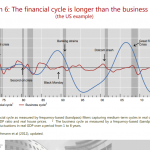WHY INFORMATION SYMMETRY CREATES WEALTH
ORIGINAL
SUMMARY
The entire theory of finance rests upon measuring the relative value that expectations (otherwise known as interest rates) add or subtract to/from an asset’s intrinsic value. For instance, as high certainty – low-interest rates- increases the value of expected cash flows Future Value, it becomes the largest component of price Present Value. In fact, if that belief is shared by many, the future value component of price becomes exchangeable (liquid), investable and reproducible as Information Symmetry[1] rises across time, place and social hierarchy. For instance, Property Rights[2] when truly enforced, instantly produce information symmetry across all relevant boundaries and with it, exponential rises in the value of most economic resources. The same principle applies to the value multiple created by Competition, Freedom of Choice, Supply/Demand, Free-Markets[3] and all patterns our minds associate with survival expediency and intuitively, long-term (economic) sustainability.
Unfortunately, the philosophical thought influencing both sides of the political spectrum today, comes from a time in history, when it would have been hard to separate the exclusively mathematical origin of financial value from the uneven impact its influence exerted on the European social fabric, after the 17th century, Fortunately, unbiased research and a vast supply of empirical data leave no room for controversy. Massive wealth creation correlates to information symmetry expansion throughout the charts, tables, and videos shown below.
[1] [The] “knowledge that some system is symmetrical reduces what we need to know about the system by eliminating possibilities that would be permitted if the system were not symmetrical. This reduction of required information is greater, the more pervasive the symmetry. The relatively low information content resulting from symmetries is reflected in the high epistemic value of knowledge of these symmetries.”
[2] “Property Rights and Markets. The optimal solution to the allocation problem requires the participants to have accurate information about the marginal costs and marginal benefits associated with specific alternatives. Problems arise when exchange is not voluntary and property rights are attenuated. Pure competition is one way to ensure that no one buyer or seller has the ability to alter the outcome of market exchanges and the information revealed in prices.”
[3] See David Ricardo’s original postulates.
CIO SYSTEMIC RISK AVERSE FUNDS





